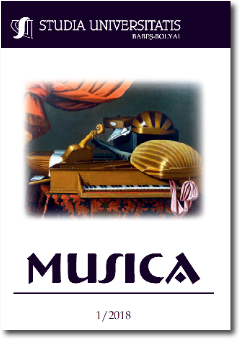ETHNOGRAPHIC AND FOLK MUSIC TRADITIONS OF JOBBÁGYTELKE (SÂMBRIAŞ) - II. PART -
ETHNOGRAPHIC AND FOLK MUSIC TRADITIONS OF JOBBÁGYTELKE (SÂMBRIAŞ) - II. PART -
Author(s): Henrietta CiobaSubject(s): Fine Arts / Performing Arts
Published by: Studia Universitatis Babes-Bolyai
Keywords: folklore; folk music; research of folk music; musical analysis; folk costumes; folk dance; folk tradition.
Summary/Abstract: The paper hereby entitled Ethnographic and Folk Music Traditions of Jobbágytelke (Sâmbriaş) presents a village in Mureş county. I started my research on this village already during my high-school years, more precisely in the school year of 2012-2013. This was the period when I collected the pieces of information regarding the traditions and folk costumes of the village and the 23 tunes that Mr. András Sinkó (my teacher of ethnography at the time) helped me do the notation for. In the first year of my university studies I extended the paper. This was the period when I collected the children’s songs, the nursery rhymes and the children’s plays that used to be played by the old generation in the nursery and in elementary school. This year I attempted to set the existing information on scientific basis and to collect more information. This is when I dwelt on the origin and historical data of the village, on the community institutions meant to preserve traditions, on folk dance and the members of the folk dance ensemble. I succeeded in noting another 21 new tunes, 3 of which I wrote down from recordings made by the late Antal Balla. In the paper I used 28 other tunes as well, besides those collected by me. For these 28 other tunes I own acknowledgements for István Almási, PhD who kindly granted that I have access to his collection kept at the Folklore Archive of Cluj-Napoca. The paper hereby could not have been written without the kind help of Ilona Szenik, PhD. It is her merit that my research can rely on scientific grounds and that the tunes are organized and have musical analysis attached to them. And last, but not least I owe acknowledgements to my thesis coordinator, PhD Júlia Köpeczi-Kirkósa to PhD Zoltán Gergely, collaborator at the Folklore Archive of Cluj-Napoca and also to my informants from the village and to all the inhabitants of the village who readily informed me and introduced me to village life.
Journal: Studia Universitatis Babes-Bolyai - Musica
- Issue Year: 63/2018
- Issue No: 1
- Page Range: 237-272
- Page Count: 36
- Language: English

